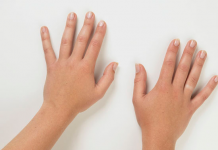PREGNANCY AND OUR HANDS: CARPAL TUNNEL SYNDROME
The hormonal changes during the pregnancy period changes the normal order of the body and prepares it for the delivery. Like all the other organs, the bones and the joints are also effected by this period. Especiall the changes on the hands are commonly observed during the pregnancy. In fact, two of every three mother candidates have a syndrome called “carpal tunnel” which seriously effects the hands. This state especially seen in the last months of the pregnancy and in the postpartum period can also be encountered as a long term effective syndrome. The recent studies give us important information regarding the progress of the disease in the long term after the delivery. In the research, it has been observed that 85 percent of the patients stating that their complaints have stopped still has the disease. Upon this information, it is logical to make hand-wrist consultation both within the last three months of the pregnancy and six-twelve months after the delivery.
WHAT IS THE CAUSE?
The performance and feeling of our hands are provided by three different nerves. One of them is called median nerve. The wrist has a narrow tunnel through which the median nevre passes. This tunnel is called carpal tunnel. The increase of pressure or the contraction of the tunnel causes the compression of the median nerve. The problems and the complaints caused by this compression is called “carpal tunnel syndrome”.
The major problem of most of the patients is the extreme thicknening of the ligament which the nevre passes under and the pressure it makes to the nerve.
In some cases, even the ligament does not thicken too much, the undergoing median nevre shows extreme sensitivity due to some substructure problems of the body. Diabetics or some tyrodid gland diseases can be given as examples. Thus, carpal tunnel syndrome is more commonly seen in endocrine diseases like diabetics.
In some cases, it is seen that the thickness of the ligament passing over the nevre is normal but the median nevre is comopressed due to the extreme crowd in the tunnel (volume decrease). Osteoarthritis and rheumatoid arthritis are some examples. Likewise, the hormonal changes seen during the pregnancy and brest-feeding period may result in the carpal tunnel disease by causing edema (water retention on the tissues) and volume decrease.
SYMPTOMS
There are three main symptoms of the carpal tunnel sydrome. Pain, tingling and numbness. The tingling and numbness is felt on the thumb, forefinger and middle finger. It is not felt on the little (fifth) finger. The symptoms are generally seen during the nights as the wrist is bended in the state of sleep. The bended wrist decreases the volume in the carpal tunnel and increases the findings. The numbness and tingling generally wakes the patient up and he usually feels the need tos hake his hand. In the next steps, incompetence (i.e. while buttoning) dropping the thins from the hand, decrease in the strenght to grasp the things and myolysis on the muscles around the thums can be observed due to the weakening of the effected muscles.
THE PREGNANCY PERIOD
It has always been wondered how often the carpal tunnel disease is seen during the pregnancy period. So, the data of 116 studies made within the last 50 years is gathered and as a result, it is found out that two of every three pregnancies have carpal tunnel disease (62%) this study has also revelaed nother interesting finding. Even the patient does not have any complaints, it is seen that the median nevre is seriously damaged within the last three months of pregnancy.
In paralel with the rapid weight loss and the dissolution of edema within the first two weeks after the delivery, pain and other findings relieve approximately in 75% of the patients. Thus, the main target of the treatment is to relieve the complaints of the patient until the delivery.
Another significant information in the recent studies is the progress of the disease after the delivery.
In a study we have performed with a test called EMG with the volunteers in one to three years after the delivery, it has been observed that the disease has continued in 85% of the patients stating that their complaints have stopped. Upon this information, it is logical to make hand-wrist consultation both within the last three months of the pregnancy and six-twelve months after the delivery.
HOW TO DIAGNOSE?
During the diagnosing period, the detailed medical history of the patient is studied. Even rarely, carpal tunnel syndrome might be the first findings of some endocrine and rheumatismal diseases. In this case, the required laboratory tests are to be made. In some arthritis-like diseases regarding the wrist, film mişght be required. To verify the diagnosis, generally a test called electromyography (EMG) is requested. In the examination made by the neurologist or physical therapist, the speed and health of the nevre conduction and other probable nevre compressions are researched.
WHAT IS THE TREATMENT IN PREGNANCY?
Upon establishing the diagnosis of the disease, the measures preventing the increase of pressure on the carpcal tunnel are taken. The wrist splint prescribed to use during the night will prevent the bending of the wrist and thus the pressure increase. Daily routine activities are changed. The patient is asked to prevent his troubled hand from vibration (driving a car, electrical household appliances like mixer). If the patient has diabetics or rheumatism, first he should be examined by a specialist. These measures are generally sufficient at the early stage. In case the complaints continue after this step, some interventions are applied to dissolve and decrease the edema in the channel. Duly performed corticosteroid (cortisone) injection (needle) can regress the edema. This injection can safely be made in the pregnancy and breast-feeding period. It has been observed that this cortisone injection has significantly relieved the tingling and numbness in four of every five patiens.
For the patients with unsuccesful results, surgical treatment is the only option. Another relieving information is that surgicak intervention is rarely needed during pregnancy period or the period after the delivery.
WHAT IS THE PROGRESS OF SURGICAL TREATMENT?
Your Hand Surgeon may ask for x-Ray graphy or EMG after the consultation. Surgical intervention is generally made under local anesthesia and the patient is disharged on the same day. During your consultation with your Hand Surgeon, it is very important to mention about your special conditions (chronic diseases, regularly taken medication etc.). In the early period after the surgery (postop 3 days), cold application and keeping your hand above the heart level will reileve the pain and throbbing. The wound is controlled by opening the bandage between 5-7 days. If there is no complication, you can take shower. Even rarely, you might need physical therapy and rehabilitation after this period. Even though the general progress changes in accordance with the surgery performed and the condition of your wrist, you are generally expected to go bak your normal life within 3 to 6 weeks.












